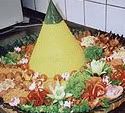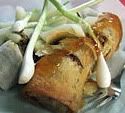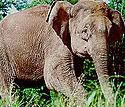HistoryGaruda, the vehicle (vahana) of Vishnu appears in many temples of ancient Indonesia. Temples such as Prambanan, Penataran, Belahan, and Sukuh depict the images (bas-relief or statue) of Garuda. In Prambanan temple complex there is a single temple located in front of Vishnu temple, dedicated to Garuda. However there is no statue of Garuda inside the chamber today. In the shiva temple, also in Prambanan complex, there is a relief telling an episode of Ramayana about Garuda Jatayu tried to rescue Sita from Ravana's hand. The deified statue of King Airlangga depicted as Vishnu mounting Garuda from Belahan, probably the most famous statue of Garuda from ancient Java. Now the statue is one of the important collection of Trowulan Museum, East Java.
Garuda appear in many traditions and stories, especially in Java and Bali. In many stories Garuda symbolizes the virtue of knowledge, power, bravery, loyalty, and discipline. As the vehicle of Vishnu, Garuda also bears the attributes of Vishnu, which symbolize preservation of cosmic order. Balinese tradition venerated Garuda as "the lord of all creatures that can fly", and "the majestic king of birds". In Bali, Garuda traditionally portrayed as a divine creature with head, beak, wings, and claw of an eagle, while has the body of a human. Usually portrayed in intricate carving with golden and vivid colors, as the vehicle of Vishnu or in battle scene against Naga (dragon) serpents. The important and noble position of Garuda in Indonesian tradition since ancient times has venerated Garuda as the national symbol of Indonesia, the embodiment of Indonesian ideology, Pancasila. Garuda also chosen as the name of Indonesian national airlines, Garuda Indonesia. Next to Indonesia, Thailand also uses the Garuda as its national symbol.
Scroll and MottoThe Garuda clutches in its talons a scroll bearing the National Motto of Indonesia, "
Bhinneka Tunggal lka" which is an Old Javanese phrase, literally meaning "(Although) in Pieces, yet One." This roughly translates to "Unity in Diversity".
SymbolismGarudaThe Garuda is the mythical golden eagle, common to both Hindu and Buddhist mythology. The Garuda was a chimera, having the wings, beak, and feet of the golden eagle, but a man's arms and trunk. The Garuda is commonly used as an emblem in South and Southeast Asian nations. The use of the Garuda in Indonesia's coat-of-arms invokes the pre-colonial Hindu kingdoms that spanned across the archipelago, from which the present-day Republic of Indonesia is understood to be descended.
However, unlike the traditional anthropomorphic form of Garuda as featured in ancient temples in Java, the Balinese Garuda, or in national emblem of Thailand, the design of Indonesia's Garuda Pancasila is rendered in modern naturalism one. The design of Garuda Pancasila was inspired by the Javan Hawk-eagle (
Spizaetus bartelsi), endangered raptor endemic to the mountainous forest regions in the island of Java. The Javan Hawk-eagle identification featured in Garuda Pancasila especially the feather crest crowning its head, and dark-brownish to chestnut-gold colouring. Because of this, the Javan Hawk-eagle is considered as the national bird of Indonesia.
As for the coat of arms, the Garuda symbolizes strength and power, while the gold colour symbolizes greatness and glory.
The feathers on the Garuda of the Indonesian coat-of-arms are arranged so that they invoke the date of 17 August 1945, the officially recognized Indonesian Day of Independence. There are 17 feathers on each wing, 8 on the tail, 19 on the base of the tail (below the shield), 45 on the neck, corresponding to the "17/8/1945" international date format for Independence.
ShieldThe shield is a martial symbol, standing for defense of the country. It is divided into five sections: a background divided into quarters, colored red and white (the colors of the national flag) in a checkerboard pattern; and a smaller, concentric shield, black in background. A thick, black line lies horizontally across the shield, symbolizing the equator which passes through the Indonesian archipelago.
EmblemsEach section of the shield has a symbol corresponding to the Pancasila principles laid down by its founder, President Sukarno.
The StarThe black shield bearing the golden star at center corresponds to the first Pancasila principle, belief in one God. The color black represent the color of nature. Upon this shield at center is a golden, five-pointed star. This is a symbol common not only among Indonesia's sanctioned faiths of Islam, Christianity, Hinduism and Buddhism, but of the secular ideology of socialism as well.
This tenet of Pancasila has always been controversial, for it suggests compulsory religious belief as well as compulsory monotheism. Supporters of Sukarno's legacy, however, believe that this tenet was meant to unify Indonesia's population, who have diverse faiths and beliefs.
The ChainIn the bottom right quarter, on a red background, is a chain made up of square and round links. This chain represents successive human generations, with the round links representing women and the square links representing men. The chain corresponds to the second principle of the Pancasila, of belief in a commonly bound humanity.
The TreeAt the upper right quarter, on a white background, is the
banyan tree (Indonesian,
beringin). This symbol corresponds to the third Pancasila principle, the unity of Indonesia. The banyan is known for having expansive above-ground roots and branches. The Republic of Indonesia, as an ideal conceived by Sukarno and the Nationalists, is one country out of many far-flung cultural roots.
The BullIn the upper left quarter, on a red background, is the head of the Javanese wild bull, the
banteng. This represents the fourth principle of Pancasila, democracy by deliberation and consensus among representatives. The banteng is a social animal, so too is humanity, and decisions must be made collectively. The banteng was also adopted as a symbol of Sukarno's Nationalists, and later by his daughter Megawati Sukarnoputri's Indonesia Democratic Party of Struggle.
Rice and CottonIn the lower left quarter, on a white background, are a gold-and-white paddy and cotton. These represent the fifth Pancasila principle of social justice. The rice and cotton represent sustenance and livelihood. (
source)
Related articles :- Elections in Indonesia
- Government and Politics
- Political System
- Reform Process


 Legian
Legian Kuta Square - Kartika Plaza
Kuta Square - Kartika Plaza







































